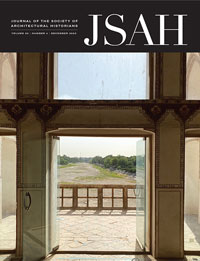Thresholds 51: Heat
Edited by Hampton Smith and Zachariah DeGiulio
Thresholds, the annual peer-reviewed journal produced by the MIT Department of Architecture and published by MIT Press is now accepting submissions to be published Spring 2023.
Heat is elusive: always on the move, always fugitive. Though we have many signs of its presence—sweating, “hot” and “cool” media, sitting under the shade, catching fire—heat itself largely evades conventional forms of representation. As the transference of energy from one system to another, heat radiates and penetrates. Immanent and intense, heat binds and nourishes as much as it reshapes or destroys. While helping us navigate the material world as tool, medium, and affect, heat forces us to come to terms with the fragility of the systems in which we take part. And though temperature is regularly mapped across graphs and thermometers, the feeling of heat is often so localized and so personal that it evades historic perception altogether. Even if we know things are hotter now than they were yesterday, where is heat within art and architecture practice?
Thresholds 51: Heat takes enthalpy—the thermodynamic property that comprises heat, pressure, and volume to effect chemical state change—as its guiding principle. We seek scholarly writing, artistic interventions, and criticism from art, architecture, and related fields to apply pressure within the volume to effect disciplinary state change. We aim to discover the ways art and architecture have historically navigated, wielded, and avoided heat.
Courtyard buildings across the Islamic world produce thermal delight; Mande blacksmiths carefully wield heat to make iron tools for repairing and nourishing communities; museum conservators curate temperature-controlled environments for artworks; Yurok practices of fire stewardship regulate natural rhythms of growth and decay. And though thermodynamic flux underlies such practices of making and maintenance, heat just as frequently effaces or prevents knowledge production—think of the conflagration of the University of Cape Town’s special collections or mold consuming boxes of archival material.
Recognizing that heat has never been evenly felt, from the violently racialized fictions of the “torrid zone” to the lack of adequate shade in urban communities, we are particularly invested in alternative architectural or aesthetic mobilizations of heat—in the contestation of thermal violence, in the activation of ritual, or in the warmth of community, desire, and lust. A critical account of heat within art and architecture must attend to its use as a medium and structure of violence, while nevertheless exploring how “feeling the heat” productively links scales of being, practices, and types of labor.
Submission deadline: June 1, 2022
Submission guidelines: Please send all submissions to the editors via email at thresh@mit.edu with the subject heading THAT’S HOT. Essay submissions should be in English, approx. 3,000 words, and formatted in accordance with the Chicago Manual of Style. Submission should include a brief cover letter, contact information, and bio of 50–75 words for each author. Text should be submitted in MS Word. Images should be submitted at 72 dpi as uncompressed TIFF files. Other creative proposals, including, but certainly not limited to, performances, poetry, and film are not limited in size or medium. All scholarly submissions are subject to peer review.


